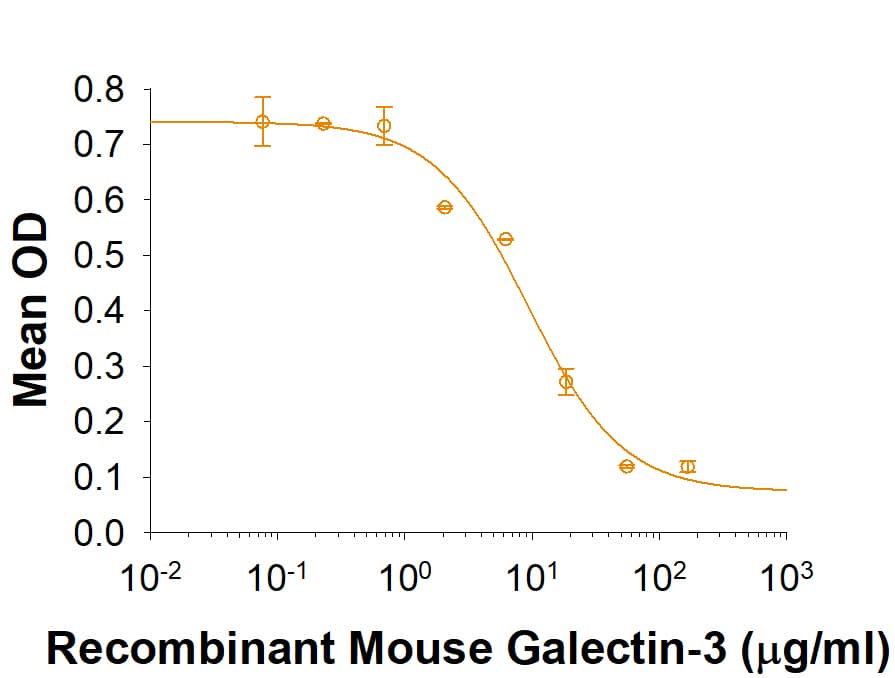Recombinant Mouse Galectin-3 Protein
R&D Systems, part of Bio-Techne | Catalog # 1197-GA

Key Product Details
Product Specifications
Source
Ala2-Ile264
Purity
Endotoxin Level
N-terminal Sequence Analysis
Predicted Molecular Mass
Activity
The ED50 for this effect is 5-20 µg/mL.
Scientific Data Images for Recombinant Mouse Galectin-3 Protein
Recombinant Mouse Galectin-3 Protein Bioactivity
Recombinant Mouse Galectin-3 (Catalog # 1197-GA) agglutinates human red blood cells. The ED50 for this effect is 5‑20 µg/mL.Formulation, Preparation and Storage
Carrier Free
What does CF mean?CF stands for Carrier Free (CF). We typically add Bovine Serum Albumin (BSA) as a carrier protein to our recombinant proteins. Adding a carrier protein enhances protein stability, increases shelf-life, and allows the recombinant protein to be stored at a more dilute concentration. The carrier free version does not contain BSA.
What formulation is right for me?In general, we advise purchasing the recombinant protein with BSA for use in cell or tissue culture, or as an ELISA standard. In contrast, the carrier free protein is recommended for applications, in which the presence of BSA could interfere.
Carrier: 1197-GA
| Formulation | Lyophilized from a 0.2 μm filtered solution in PBS, EDTA and DTT with BSA as a carrier protein. |
| Reconstitution | Reconstitute at 250 μg/mL in sterile PBS containing at least 0.1% human or bovine serum albumin. |
| Shipping | The product is shipped with polar packs. Upon receipt, store it immediately at the temperature recommended below. |
| Stability & Storage | Use a manual defrost freezer and avoid repeated freeze-thaw cycles.
|
Carrier Free: 1197-GA/CF
| Formulation | Lyophilized from a 0.2 μm filtered solution in PBS, EDTA and DTT. |
| Reconstitution | Reconstitute at 250 μg/mL in sterile PBS. |
| Shipping | The product is shipped with polar packs. Upon receipt, store it immediately at the temperature recommended below. |
| Stability & Storage | Use a manual defrost freezer and avoid repeated freeze-thaw cycles.
|
Background: Galectin-3
References
- Robertson, M.W. et al. (1990) Biochemistry 29:8093.
- Elola, M.T. et al. (2007) Cell. Mol. Life Sci. 64:1679.
- Haudek, K.C. et al. (2010) Biochim. Biophys. Acta 1800:181.
- Hughes, R.C. (1999) Biochim. Biophys. Acta 1473:172.
- Krzeslak, A. and A. Lipinska (2004) Cell. Mol. Biol. Lett. 9:305.
- Dumic, J. et al. (2006) Biochim. Biophys. Acta 1760:616.
- Sano, H. et al. (2003) J. Clin. Invest. 112:389.
- Ahmad, N. et al. (2004) J. Biol. Chem. 279:10841.
- Friedrichs, J. et al. (2008) J. Biol. Chem. 283:32264.
- Wen, Y. et al. (2006) J. Cell. Biochem. 98:115.
- Zhuo, Y. et al. (2008) J. Biol. Chem. 283:22177.
- Henderson, N.C. and T. Sethi (2009) Immunol. Rev. 230:160.
- Kohatsu, L. et al. (2006) J. Immunol. 177:4718.
- Nieminen, J. et al. (2008) J. Immunol. 180:2466.
- Henderson, N.C. et al. (2008) Am. J. Pathol. 172:288.
- Newlaczyl, A.U. and L.G. Yu (2011) Cancer Lett. 313:123.
- Sherwi, N. et al. (2012) Future Cardiol. 8:885.
- Shin, T. (2013) Acta Histochem. 115:407.
Alternate Names
Gene Symbol
UniProt
Additional Galectin-3 Products
Product Documents for Recombinant Mouse Galectin-3 Protein
Product Specific Notices for Recombinant Mouse Galectin-3 Protein
For research use only
